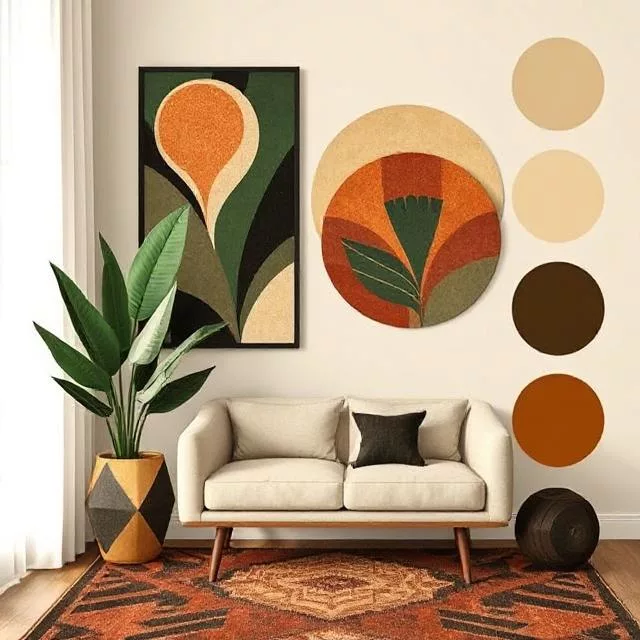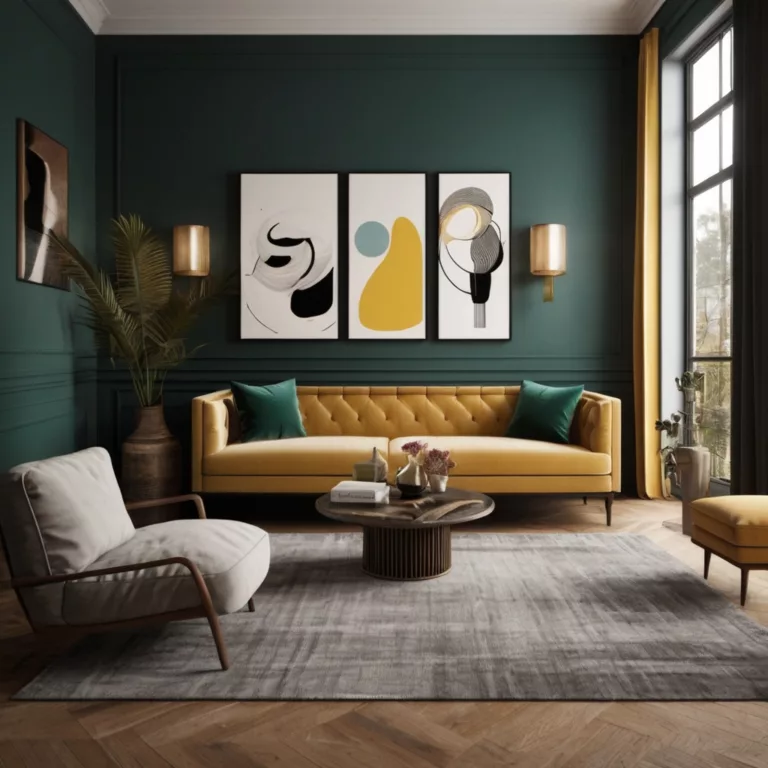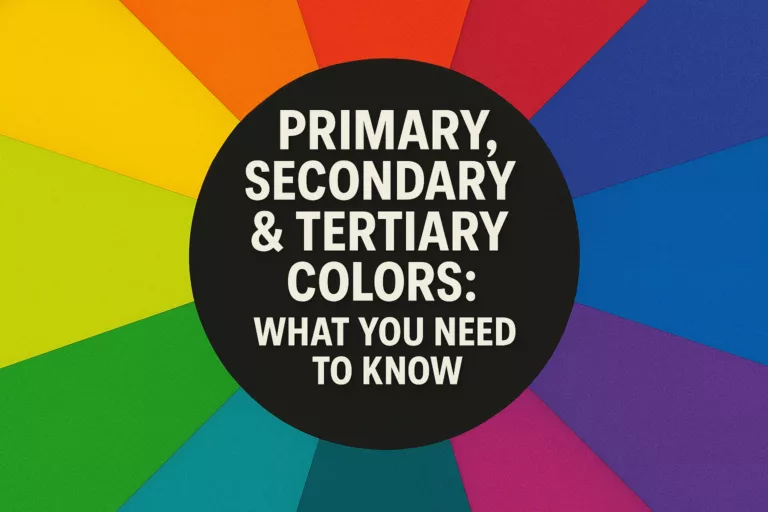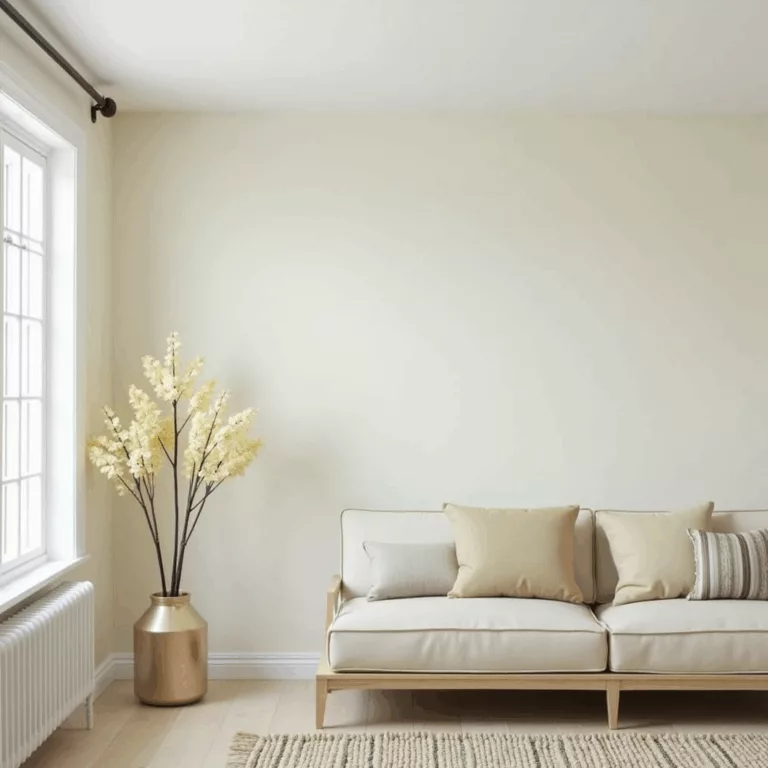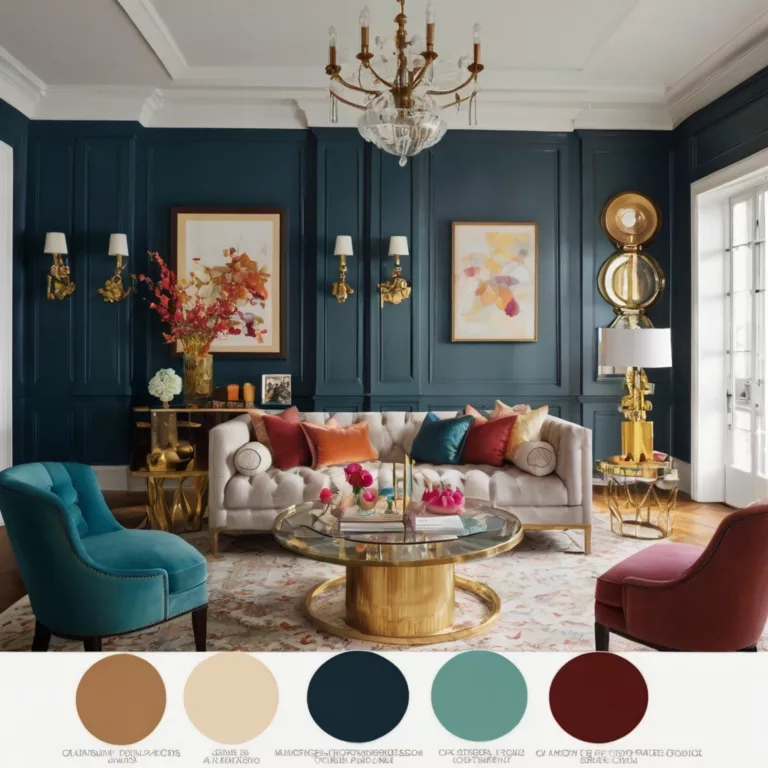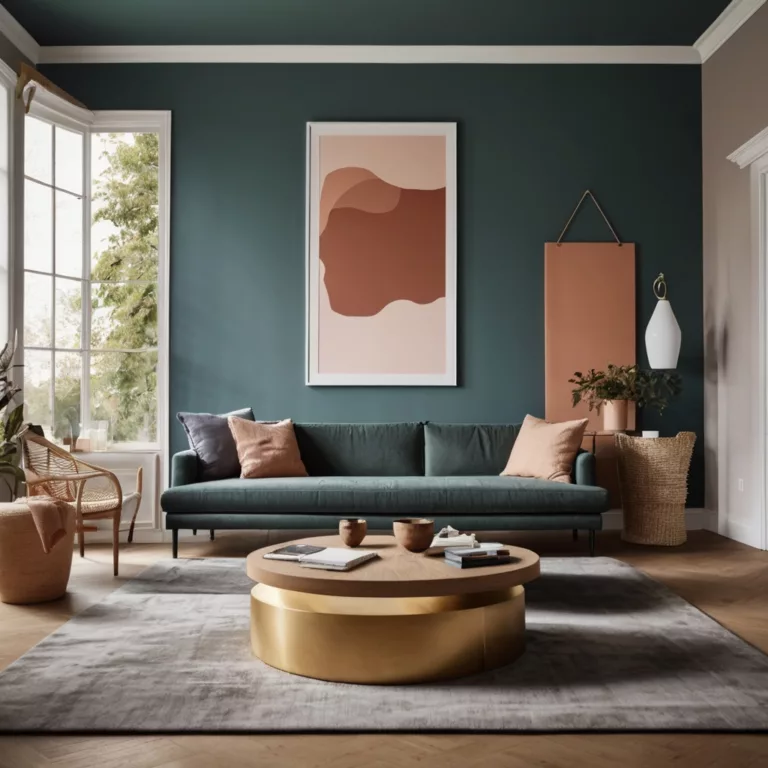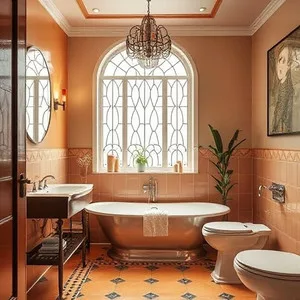Bringing the Outdoors In: Earth-Inspired Color Schemes for Interior Renewal
Introduction to Earth-Inspired Color Schemes
The marriage between interior design and nature has been a timeless pursuit across civilizations. Earth-inspired color schemes represent more than mere aesthetic choices; they embody philosophical connections between human dwellings and the natural world. This comprehensive exploration delves into how earth-toned color palettes—particularly those with historical significance in Islamic and Arabic art traditions—can transform modern living spaces into sanctuaries of tranquility and spiritual connection.
When we examine the concept of bringing the outdoors in, we discover a design philosophy deeply rooted in both practical and symbolic considerations. Earth-inspired color schemes don’t simply mimic nature; they translate its essence into interior environments that promote wellbeing, connection, and harmony.
Historical Perspectives on Earth Colors in Middle Eastern Design
The traditions of Islamic and Arabic design have championed earth-inspired colors for centuries, establishing an unbroken lineage of interior aesthetics that remains relevant today. From the sun-baked clay buildings of ancient Mesopotamia to the intricate geometric patterns adorning medieval mosques, earth-inspired color schemes have served as both functional adaptations to desert environments and powerful symbolic languages.
Archaeological evidence from early Islamic settlements reveals sophisticated understanding of how certain earth tones could regulate temperature, reflect light, and create psychologically comforting spaces. These weren’t random color selections but carefully considered design systems that acknowledged human responses to specific hues.
The Symbolic Language of Color in Islamic Tradition
The symbolic significance of colors in Islamic art and architecture constitutes one of the world’s most sophisticated color theories, where each earth-inspired color scheme carries multiple layers of meaning:
Green: Paradise and Spiritual Renewal
The color green holds paramount importance in Islamic symbolism, representing paradise, fertility, and spiritual renewal. Prophet Muhammad is said to have favored green, establishing it as a color of spiritual significance. In traditional interior renewal practices, green accents were incorporated to evoke spiritual awakening and connection to divine creation.
Modern applications of green in earth-inspired interiors might include:
- Emerald green textiles as focal points in neutral rooms
- Sage green walls paired with natural wood elements
- Olive green upholstery complemented by terracotta accessories
Blue: Divine Protection and Infinity
Blue symbolizes divine protection, heavenly realms, and infinity in Islamic color tradition. The famous blue tiles of mosques in Iran and Turkey showcase this color’s spiritual significance. Incorporating blue into earth-inspired color schemes connects interior spaces to both sky and water elements.
Contemporary design applications include:
- Indigo textiles against warm earth-toned walls
- Turquoise decorative elements paired with natural sisal or jute
- Cerulean blue ceilings representing the infinite heavens above
Red and Terracotta: Life Force and Earth Connection
Red tones, particularly terracotta, symbolize life force, earth connection, and protection in Islamic design tradition. These colors feature prominently in traditional ceramics, textiles, and architectural elements. When considering interior renewal through earth-inspired palettes, these warm tones create grounding environments.
Modern interpretations include:
- Terracotta feature walls with minimalist furnishings
- Rust-colored textiles against neutral backgrounds
- Clay-toned decorative objects as color anchors
Gold and Yellow: Divine Light and Prosperity
Gold and yellow represent divine illumination, knowledge, and prosperity in Islamic art. These colors appear in manuscripts, architectural details, and ceremonial spaces. Incorporating these tones into earth-inspired color schemes brings warmth and luminosity to interior environments.
Contemporary applications include:
- Ochre textiles against deep blue backgrounds
- Bronze metallic finishes on decorative objects
- Amber-toned lighting fixtures to create warmth
The Mathematics of Color Harmony in Islamic Design
What distinguishes Islamic approaches to earth-inspired color schemes is their mathematical precision. Color relationships in traditional Islamic design follow specific proportional systems, creating harmonious environments through calculated color balance rather than intuitive combinations.
The mathematical principles governing these color relationships include:
- Golden ratio proportions in color distribution
- Geometric progression of color intensity
- Complementary color pairs based on sacred geometry
These principles ensure that interior renewal projects using earth-inspired palettes maintain visual harmony while honoring traditional color wisdom.
Regional Variations in Earth-Inspired Color Traditions
Islamic and Arabic color traditions vary significantly by region, reflecting local materials, climate conditions, and cultural influences:
North African Earth Palette
Morocco, Tunisia, and Algeria developed distinctive earth-inspired color schemes characterized by:
- Vibrant blues contrasting with earthen walls
- Intricate color transitions in zellige tilework
- Berber-influenced patterns using ochre, saffron, and indigo
These North African palettes have become globally influential in contemporary interior renewal movements, particularly in bohemian and Mediterranean-inspired designs.
Levantine Color Traditions
Syria, Lebanon, and Palestine developed subtler earth-inspired color schemes featuring:
- Pale stone tones with selective color accents
- Damascene color combinations of rose, cream, and sage
- Mother-of-pearl inlay creating luminous effects against earth tones
These more restrained palettes influenced European interior design during various Oriental revival periods.
Persian Color Sophistication
Persian earth-inspired color schemes represent perhaps the most complex systems, with:
- Integrated color theories connecting architecture to miniature painting
- Systematic use of complementary colors in precise proportions
- Poetic associations between colors and emotional states
These sophisticated approaches to color continue to influence global design aesthetics, particularly in luxury interiors.
Implementing Earth-Inspired Color Schemes in Contemporary Spaces
Translating the rich heritage of Islamic color symbolism into modern interior renewal projects requires thoughtful consideration of several factors:
Color Psychology and Spatial Experience
Research confirms that earth-inspired colors affect human psychology in predictable ways:
- Terracotta and clay tones promote groundedness and security
- Muted greens reduce stress and promote healing
- Sand and stone colors create perceptions of expanded space
Understanding these psychological effects allows designers to create intentional emotional experiences through earth-inspired color schemes.
Sustainable Color Practices
Traditional Islamic color production utilized natural pigments and materials, establishing early sustainable design practices:
- Mineral-based pigments with minimal environmental impact
- Local sourcing of coloring materials
- Non-toxic application methods passed through generations
Contemporary interior renewal projects can honor this heritage by choosing eco-friendly paints, natural dyes, and sustainably produced materials that reflect these values.
Cultural Appreciation vs. Appropriation
When incorporating Islamic color traditions into modern interiors, ethical considerations include:
- Acknowledging the cultural origins of specific color combinations
- Supporting artisans from relevant cultural backgrounds
- Understanding the symbolic meanings behind color choices
This ensures that earth-inspired color schemes honor rather than exploit cultural heritage.
Practical Applications for Modern Interiors
Living Spaces
For living rooms and communal spaces, earth-inspired color schemes might include:
- Wall colors in warm clay tones (Terracotta, Adobe, Sienna)
- Accent colors drawn from traditional Islamic palette (Lapis Blue, Emerald Green)
- Neutrals inspired by natural materials (Limestone, Sand, Driftwood)
These combinations create welcoming environments that promote both social connection and relaxation.
Meditative Spaces
For bedrooms and contemplative areas, consider:
- Cooler earth tones promoting rest (Sage, Stone, Pale Sky)
- Minimal color contrasts for visual serenity
- Strategic use of traditional blues and greens with spiritual associations
These earth-inspired color schemes support sleep quality and meditative practices.
Creative Workspaces
For home offices and creative studios, effective combinations include:
- Stimulating yet grounded color combinations (Ochre with Turquoise accents)
- Colors traditionally associated with knowledge and creativity
- Dynamic contrasts balanced by unifying neutral tones
These palettes promote focused work while maintaining connection to natural rhythms.
Case Studies in Earth-Inspired Interior Renewal
Modern Moroccan Fusion
A California residence successfully implemented earth-inspired color schemes by:
- Adapting traditional Moroccan blue-and-clay combinations for Western architecture
- Incorporating locally-sourced materials with authentic pigmentation
- Creating transitional spaces between indoor and outdoor environments
This project demonstrated how Islamic color traditions can enhance contemporary sustainable architecture.
Urban Sanctuary in Dubai
A high-rise apartment transformed through:
- Earth-toned micro-cement finishes referencing desert landscapes
- Strategic use of traditional Islamic blue-green combinations
- Copper and bronze accents creating warmth and connection to regional metalwork
This project showcased how vertical living can maintain connection to earth elements through thoughtful color application.
Historic Renovation in Istanbul
A traditional Ottoman house renovated with:
- Historically accurate pigments created by local artisans
- Color zoning reflecting traditional spatial organizations
- Contemporary furnishings in complementary earth tones
This project balanced heritage preservation with modern functionality through earth-inspired color schemes.
Future Directions in Earth-Inspired Design
As interior design continues to evolve, several emerging trends connect to Islamic color traditions:
Biophilic Color Integration
Advanced understanding of how earth colors affect human biology is leading to more sophisticated interior renewal approaches:
- Circadian-supportive color schemes changing throughout the day
- Biologically optimized color combinations promoting specific wellness outcomes
- Integration of living elements with complementary color palettes
These approaches extend traditional wisdom with scientific validation.
Digital-Physical Color Harmony
As virtual environments become increasingly important, designers are creating:
- Digital interfaces with colors harmonizing with physical earth-toned surroundings
- Augmented reality experiences enhancing traditional color experiences
- Smart lighting systems programmed to reference historic Islamic color transitions
These innovations maintain connection to earth-inspired traditions while embracing technological advancement.
Climate-Responsive Color Design
As climate challenges intensify, designers are revisiting traditional wisdom:
- Thermal-responsive color strategies from desert architecture
- Regional color palettes adapted for changing environmental conditions
- Water-conscious color production methods inspired by historical practices
These approaches recognize that earth-inspired color schemes have always been adaptive responses to environmental conditions.
Conclusion: The Timeless Relevance of Earth-Inspired Color
The profound connection between Islamic color traditions and contemporary interior renewal practices reveals an enduring truth: our need for connection to earth elements transcends time, culture, and technological development. By understanding the symbolic language of color developed through centuries of Islamic art and design, today’s interior environments can achieve not merely aesthetic appeal but deeper resonance with human psychological and spiritual needs.
As we continue bringing the outdoors in through thoughtfully applied earth-inspired color schemes, we participate in a design conversation that has engaged humanity since our earliest dwelling places. The sophisticated color wisdom of Islamic traditions offers particular insight for creating spaces that honor both our natural origins and our highest aspirations.
Further Resources
- The Symbolism of Color in Islamic Art
- Earth Pigments in Traditional Architecture
- Islamic Geometric Patterns and Color Theory
- Biophilic Design: Science, Theory, Economics, Practice
- Traditional Color Production Methods in Middle Eastern Crafts
This article is part of our ongoing series exploring the intersection of cultural color traditions and contemporary interior design. For related content, see our pieces on Japanese Wabi-Sabi Color Applications and Indigenous Earth Palette Traditions.
Art11deco

